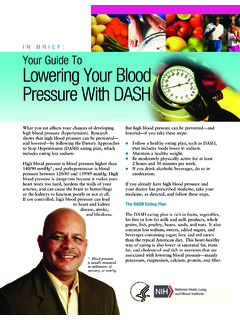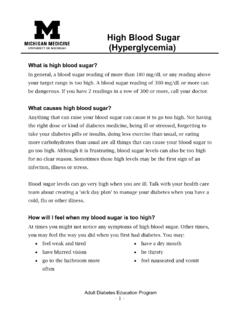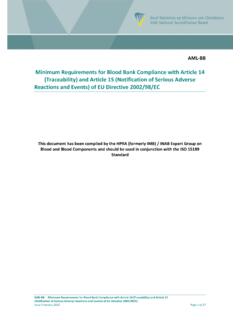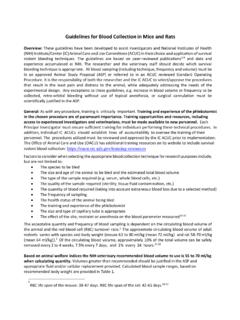Transcription of Blood Folate Levels: The Latest NHANES Results
1 NCHS Data Brief No. 6 May 2008 Folate is an essential vitamin for good health. Women of childbearing age are among the population subgroups that have been shown previously to have low Blood Folate levels (1,2). Low Blood Folate levels are associated with an increased risk of neural tube birth defects. Beginning in 1998, the Food and Drug Administration (FDA) required the addition of folic acid (a form of Folate ) to all enriched breads, cereals, flours, corn meal, pasta products, rice, and other cereal grain products sold in the United States (3). Blood Folate data from the National Health and Nutrition Examination Surveys ( NHANES ) have documented improvements in the Folate status of the population after Folate fortification was implemented (4). Red Blood cell (RBC) Folate measures long-term Folate intake and low levels are associated with adverse health effects. Serum Folate reflects recent Folate intake and low levels are an early indicator of inadequate Folate status.
2 Pre- and postfortifica-tion Blood Folate levels of the population 4 years of age and older and prevalence of low Blood Folate among women of childbearing age (15 45 years) are reported. Keywords: folic acid fortification, prevalence, red Blood cell Folate , serum Folate , survey, trends, National Health and Nutrition Examination DEPARTMENT OF HEALTH AND HUMAN SERVICESC enters for Disease Control and PreventionNational Center for Health StatisticsKey findingsData from the National Health and Nutrition Examination SurveysVery large increases in Blood Folate levels of the population occurred between 1988 1994 and 1999 2000. Small fluctuations in Blood Folate levels occurred over the time period 1999 2006. The median red Blood cell (RBC) Folate level of the population 4 years of age and older was 266 ng/mL in 2005 2006. The median serum Folate level of the population 4 years of age and older was ng/mL in 2005 2005 2006, the preva- lence of low RBC Folate (less than 140 ng/mL) among women of childbearing age (15 45 years) was In 2005 2006, the preva- lence of low serum Folate (less than 3 ng/mL) among women of childbearing age was Blood Folate Levels: The Latest NHANES ResultsMargaret A.
3 McDowell, , ; David A. Lacher, ; Christine M. Pfeiffer, ; Joseph Mulinare, , ; Mary Frances Picciano, ; Jeanne I. Rader, ; Elizabeth A. Yetley, ; Jocelyn Kennedy-Stephenson, ; and Clifford L. Johnson, 1988 19941999 20002001 20022003 20042005 2006 Figure 1. Median RBC Folate levels (ng/mL) of the population, 1988 2006 010015050200250300 YearMedian RBC Folate (ng/mL)Persons 4 years of age and olderFemales 15 45 years of ageNOTES: Statistically significant difference between 1988 1994 and 1999 2000 for both groups. Statistically significant difference between 2001 2002 and 2003 2004 for both groups. Statistically significant difference between 2003 2004 and 2005 2006 for both groups. RBC is red Blood : CDC/NCHS, National Health and Nutrition Examination Surveys. 2 NCHS Data Brief No. 6 May 2008 3 Have levels of RBC Folate , a measure of long-term body stores changed since NHANES III (1988 1994)?Median RBC Folate levels increased between 1988 and 1994 (prefortification) and 1999 and 2000 (postfortification) followed by small fluctuations between 1999 2000 and 2005 RBC Folate levels of persons 4 years of age and older increased nearly 60%, from 174 ng/mL to 276 ng/mL between 1988 1994 and 1999 2000.
4 The NHANES 2005 2006 value is 266 RBC Folate levels of women of childbearing age increased 65%, from 160 ng/mL to 264 ng/mL between 1988 1994 and 1999 2000. The NHANES 2005 2006 value is 257 ng/mL. Has the prevalence of low RBC Folate (less than 140 ng/mL) improved since NHANES III (1988 1994)? The prevalence of low RBC Folate in the population 4 years of age and older declined from in 1988 1994 to in 1999 2000 and rates have remained low since that RBC Folate is of particular concern for women of childbearing age. The prevalence of low RBC Folate among women of childbearing age declined from in 1988 1994 to in 1999 2000. The 2005 2006 value was The prevalence of low RBC Folate was consistently higher among non-Hispanic black women compared with non-Hispanic white and Mexican-American women. Significant improvements have been made in the RBC Folate status of all race and ethnicity groups. Among non-Hispanic 1988 19941999 20002001 20022003 20042005 2006 YearPercent1 Significantly different from non-Hispanic white persons and Mexican-American different from 2003 : 1988 1994 rates significantly different from those of the 1999 2006 survey periods.
5 RBC is red Blood : CDC/NCHS, National Health and Nutrition Examination Surveys. 010203040506070 Figure 2. Prevalence of RBC Folate less than 140 ng/mL by racial and ethnic group: Females 15 45 years of age, United States, 1988 , whiteNon-Hispanic black Mexican American 2 NCHS Data Brief No. 6 May 2008 3 black women, the prevalence of low RBC Folate declined from in 1988 1994 to in 1999 2000. During the same time period, the prevalence of low RBC Folate declined from to among non-Hispanic white women and from to among Mexican-American 2005 2006, the prevalence of low RBC Folate was for non-Hispanic black, for non-Hispanic white, and for Mexican-American women. Did NHANES 2005 2006 RBC Folate levels differ by sex and age? Median RBC Folate levels varied by sex and age. RBC Folate levels were lowest among adolescents 12 19 years of age and highest among adults 60 years of age and 60 years of age and older had higher median RBC Folate levels (347 ng/mL) compared with males 60 years of age and older (304 ng/mL).
6 Were there race and ethnicity differences in median RBC Folate levels of women of childbearing age in 2005 2006? Median RBC Folate levels of women of childbearing age varied by race and median RBC Folate level of non-Hispanic black women (210 ng/mL) was significantly lower compared with non-Hispanic white and Mexican-American women, whereas the median levels of non-Hispanic white (272 ng/mL) and Mexican-American (252 ng/mL) women were similar. Figure 3. Median RBC Folate levels by sex and age: United States, 2005 20061 Significantly different from persons 4 11, 20 59, and 60 years of age and different from persons 4 11, 12 19, and 20 59 different from males 60 years of age and : RBC is red Blood : CDC/NCHS, National Health and Nutrition Examination Surveys. 050100150200250300350400 Total sampleMaleFemale4 11 years12 19 years20 59 years60 years of age and olderMedian RBC Folate (ng/mL)266123426123322682541233230426512 372712,3347 4 NCHS Data Brief No. 6 May 2008 5 Have median serum Folate levels, a measure of recent Folate intake, changed since NHANES III (1988 1994)?
7 Median serum Folate levels nearly tripled for the population 4 years of age and older from ng/mL in 1988 1994 (prefortification) to ng/mL in 1999 2000 (postfortification). After a modest decline in median serum Folate levels from 1999 2000 through 2003 2004, the 2005 2006 estimate of ng/mL shows no change since the previous 2-year serum Folate levels of women of childbearing age (15 45 years) increased from ng/mL in 1988 1994 to ng/mL in 1999 2000. The NHANES 2005 2006 value is ng/mL. Has the prevalence of low serum Folate (less than 3 ng/mL) improved since 1988 1994?The prevalence of low serum Folate in the population 4 years of age and older declined from in 1988 1994 to in 1999 2000 and rates have remained below 1% since that prevalence of low serum Folate among women of childbearing age declined from in 1988 1994 to in 1999 2000. The prevalence of low serum Folate has remained low and stable among women of childbearing age between 1999 2000 and 2005 2006.
8 There were no race and ethnicity differences in the prevalence of low serum Folate among women of childbearing age in 2005 2006. The prevalence of low serum Folate was overall and the rates were for Mexican-American women, for non-Hispanic black women, and for non-Hispanic white women. NOTE: Statistically significant differences between 1988 1994 and 1999 2000 and between 1999 2000 and 2001 2002 for both groups. Statistically significant difference between 2001 2002 and 2003 2004 for persons 4 years of age and : CDC/NCHS, National Health and Nutrition Examination 4. Median serum Folate levels (ng/mL) of the population, 1988 2006 Median serum Folate (ng/mL)0428612141016 Persons 4 years ofage and olderFemales 15 45 years of age 1988 19941999 20002001 20022003 20042005 2006 Year 4 NCHS Data Brief No. 6 May 2008 5 Did median serum Folate levels differ by sex and age in 2005 2006? Serum Folate levels were highest in young children and older adults; median serum Folate was significantly higher in children 4 11 years of age and adults 60 years of age and older compared with adolescents 12 19 years of age and adults 20 59 years of age.
9 Females 60 years of age and older had the highest median serum Folate level ( ng/mL) and their serum Folate level was significantly higher compared with their male counterparts ( ng/mL). Did median serum Folate levels of women of childbearing age (15 45 years) vary by race and ethnicity group in 2005 2006? Non-Hispanic white women had significantly higher median serum Folate ( ng/mL) compared with non-Hispanic black ( ng/mL) and Mexican-American women ( ng/mL).SummaryThe NHANES data demonstrate that measures of Folate status that reflect both short-term and long-term Folate intake have improved. The median serum and RBC Folate levels of the population 4 years of age and older and of women of childbearing age have increased significant-ly over the time period from 1988 to 2006. The large increases in Blood Folate levels that occurred between 1988 1994 and 1999 2000 were followed by small fluctuations from 1999 to 2006. In addition to the overall trends in Blood Folate , the most recent NHANES data also showed that the prevalence of low Blood Folate has improved among women of childbearing age.
10 The preva-lence of low serum Folate among women of childbearing age was very low in all racial and ethnic groups and significant reductions in the prevalence of low RBC Folate have also occurred in all Figure 5. Median serum Folate levels by sex and age: United States, 2005 2006024681012141618 Total sampleMaleFemale4 11 years12 19 years20 59 years60 years of age and olderMedian serum Folate (ng/mL)1 Significantly different from persons 4 11 and 60 years of age and different from males 60 years of age and : CDC/NCHS, National Health and Nutrition Examination Surveys. 6 NCHS Data Brief No. 6 May 2008 7 racial and ethnic subgroups. Government agencies, health care organizations, and health care providers are continuing to work together to educate consumers, particularly minority women of childbearing age, to consume adequate amounts of Folate . DefinitionsFolate: a water-soluble B vitamin that is found in many acid: Folic acid is the synthetic form of Folate that is found in dietary supplements and added to enriched flour and grain products such as breads, pasta, rice, and cereals.

















